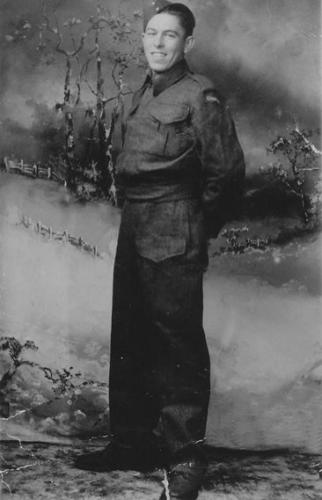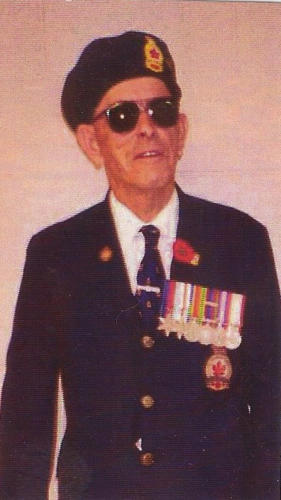Wartime Heritage
ASSOCIATION



Harold Douglas Hines
Serving His Country Changed His Life Forever
[This article was first published in the Vanguard in 2001; reprinted here with the permission of the author]
By Laurent d’Entremont
One Week before Christmas in December 1944 was not the best of times
for Harold Douglas Hines, of Central Argyle, Yarmouth County. At that time
the 20-year-old became a casualty of war for the second time. He was only 19
the first time he was injured. The German army was fighting tooth and nail
and had no plans of giving up one single inch of captured land. However it
took more than machine gun fire and hand grenades to keep the young
soldier down. Hines would rise to the challenge, return home to lead a full
and remarkable life, with lots of adjustments along the way.
He was born in the fall of 1924 and unlike many of his generation he
never went fishing. Instead, to earn his living, he drove a truck for Eddie
Hines, a relative who operated a general store in Central Argyle for many
years. Young Harold enjoyed working for him, especially driving the delivery
truck. This was sixty years ago and there was a war going on and some of the
Hines boys, Ralph, Brad and Frank, were already working for the war effort,
Harold and his younger brother Fred (a municipal councilor for many years)
wanted to do the same. These were exciting times and they wanted to be
part of the action too.
Harold Hines enlisted in the Canadian Army in 1943, and trained at
Aldershot, the base camp near Kentville. His regiment number was F-57712.
Soon he was shipped overseas to serve with reinforcement troops to relieve
those who were battling it out on the front lines. The Dutch liner, which
transported him and 12,000 others, was the Nieuw Amsterdam, about the
size of the well-known Queen Mary. He still remembers the nurses on the top
deck going to serve at Canadian hospitals in England and how beautiful they were.
This huge Liner, zigzagging a course to avoid German torpedoes, routine during the war, would eventually take them up
the Clyde River and make port in Scotland. It was on this huge ship that Harold Hines had a taste of what real fire power was all
about. The officers in command thought they had sighted a German U-boat ready to blast them out of the water. Luckily it was
only a large whale finning on the water, but perhaps not so lucky for the large mammal which may or may not have escaped.
The Central Argyle soldier had trained earlier as a rifleman at Aldershot and had done lots of target practice, mostly aiming
at a moving target on the water, which he says he missed almost all of the time. At an old British base the young Canadian joined
the Blackwatch Regiment from Montreal, a tough unit where French and English fought side by side for a common cause. The
fighting crew went into Normandy and served on the front lines as reinforcement troops.
In Europe the slit trenches, unlike those from the “Old War”, were only six feet long where two men lived, slept and
suffered---one man slept while the other kept guard with bolt action guns ready for the enemy. During a major attack Hines was
hit in the knee by flying metal, this put him out of duty for seven weeks, he was operated upon and soon recovered. During that
battle the injured Nova Scotian saw a young German soldier running towards him, the soldier who was without his gun and with
both hands on his helmet felt it was better to surrender than die for his mother land. He was too far into allied territory to
return to his regiment. Hines still remembers the young German as a lad of about 18 years, with blond hair. The young “Gerry”
was turned over to the medics in charge of the field hospital, a prisoner of war. He could very well still be living today.
The knee injury was a sample of war with, unfortunately, more to come. In Holland the Maas River is 575 miles long, rising
in France and flowing through Belgium and Holland then curving west to the Rhine before emptying into the North Sea. This
navigable river had machine gun outposts along its banks like many European rivers. Harold Hines and two other soldiers were
“dug in” into their trench manning some of the machine guns; he still remembers it was early Sunday morning, a night black as
pitch when all hell broke out. Hines was sleeping when a blast too close for comfort exploded some of their own grenades along
with lots of other ammunitions.
All three soldiers were injured, but the Argyle native knew he was the one who would never see again. It was December
1944 and unknown to the disable soldier he would live another sixty years. Some time later with lots of other casualties, he was
flown out on a DC-3 airplane to an airbase in Brussels, Belgium. There he was hospitalized and given a Braille watch. It would be
a long way to recovery and a new way of life, something that he mastered very well. All who know him will agree on this.
With lots of others who had been injured, he returned to Halifax on a hospital
ship and later went to Toronto where he learned to type and learn Braille. When
schooling was done in Toronto, the war veteran once again returned to Halifax
where he was employed running the canteen at the main post office. There he met
Bernice who was working in the same building, and later became his wife. Also in
the same building there was a young weatherman who became a close friend of the
affable canteen operator---his name was Rube Hornstein, who later became popular
as CBC’s famed TV weatherman.
After working some years in Halifax, Hines returned home to Argyle and
bought Eddie Hines’ store, where he started out many years before driving the little
delivery truck. When asked if making change at the till was a problem, he says he
could always tell by the size of the coins if it was a dime, nickel, quarter etc. When
it came to bills he knew and trusted the customers and says he was only short-
changed once when a young fellow passed a one-dollar bill and pretended it was two
dollars. However the boy was caught and justice was done---he gave back the dollar.
Perhaps the most challenging part of running the store was that he burned
wood for heat and did all his wood chopping with an ax, he was very careful and
never had an accident. As we all know, chopping wood is dangerous at the best of
times. Today having just turned 77, Harold Hines is fit as a fiddle, and as sharp as
the proverbial tack. A very cheerful man, if he has any disappointments or regrets
he certainly does not show them. He has never seen his wife or their two lovely
daughters, Wendy and Stephanie, and all family and friends love him.
He can still recall dates and events as if they had only happened yesterday. In a recent interview he was eager to tell me
he had once met General Henry Crerar (1888-1965), and had personally seen Field Marshal Bernard L. Montgomery (1887-1976)
of Alamein fame, and the Great Winston Churchill (1874-1965) of Britain. The latter was smoking his trademark cigar at the
time, and likely was sporting a belt of spirit as well.
The former soldier is an avid bingo player with his Braille cards, and over the years he has attended many Remembrance
Day ceremonies all over the country. Living nearby, Harold Hines is well known by the Pubnico people (I remember him from 50
years ago, but only spoke to him recently) as well as people throughout the counties. Although he has not seen in 57 years, he
leads a very adjusted and productive life, and likely had greater vision than any of us---especially at this time of year.

copyright © Wartime Heritage Association
Website hosting courtesy of Register.com - a web.com company


- World War I - Menu
- WWI Stories and Articles
- Photos - Yarmouth Soldiers
- Selection of World War I Songs
- WWI Casualties of Yarmouth, NS
- Those Who Served - Yarmouth, NS
- WWI Casualties Digby Co. NS
- WWI Casualties Shelburne Co. NS
- Merchant Mariners (1915) Yarmouth, NS
- Canadian Forestry Corps - Non Yarmouth Birth/Residence Enlistments
- US Draft Registry - Yarmouth NS Born


- World War II - Menu
- WWII Stories and Articles
- Telegraphist Air Gunners
- WWII Casualties of Nova Scotia
- US Casualties with NS Connection
- Far East/Pacific Casualties with NS Connection
- Merchant Navy Casualties Nova Scotia
- Nova Scotia WWII Casualties Holten Canadian War Cemetery
- D-Day Casualties - Nova Scotia
- CANLOAN Program Casualties - Nova Scotia
- Battle of the Bulge Casualties - Nova Scotia
- WWII Casualties Yarmouth NS
- Yarmouth Casualties - RCAF RAF Canadian Army WWII
- Yarmouth Co., Marrages WWII
- Casualties Non-Born/Residents with Connection to Yarmouth Co., Nova Scotia.
- WWII Casualties Digby Co., NS
- Non-Nova Scotian WWII Casualties Buried in Nova Scotia
- WWII RCAF Casualties Aged 16-18
- Brothers/Sisters Who Served - World War II















